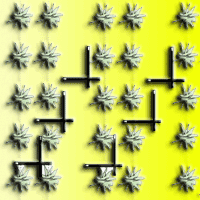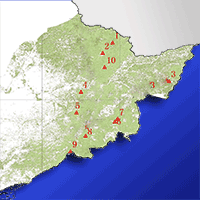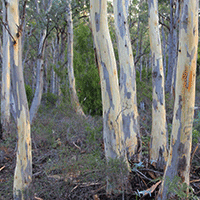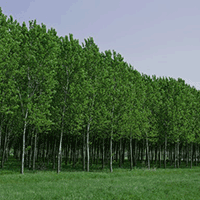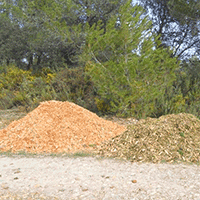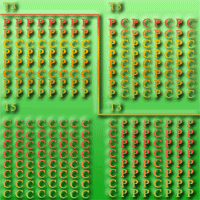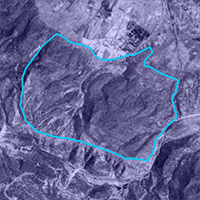
First vs. second rotation of a poplar short rotation coppice: leaf area development, light interception and radiation use efficiency
Laura S Broeckx, Stefan PP Vanbeveren , Melanie S Verlinden, Reinhart Ceulemans
iForest - Biogeosciences and Forestry, Volume 8, Issue 5, Pages 565-573 (2015)
doi: https://doi.org/10.3832/ifor1457-008
Published: Apr 27, 2015 - Copyright © 2015 SISEF
Research Articles
Abstract
Given the high expectations for lignocellulosic biomass as one of the potential solutions for energy security and climate change mitigation, commercial scale studies over several rotations are crucial to assess the potential and the sustainability of short rotation coppice (SRC) cultures for bioenergy. The first and the second rotation of the SRC poplar (Populus) plantation of the present study differed significantly in biomass yield and in productivity determinants and their relationships. Coppicing enhanced leaf area development, radiation interception and woody biomass productivity. High total leaf area and radiation use efficiency (RUE) equally contributed to the high biomass yield during the establishment rotation, while RUE became the most important determinant of biomass yield after coppice. The study confirmed the significant genotypic variation in biomass productivity and its underlying determinants, also among more recently selected poplar genotypes. The absence of a correlation between intercepted radiation and RUE suggests the potential of selecting for genotypes combining high total leaf area and photosynthetic carbon uptake in future breeding programs for yield maximization towards sustainable bioenergy cultivation.
Keywords
Genotypic Variation, Leaf Area Index, Aboveground Woody Biomass Productivity, Bioenergy, Populus, POPFULL
Authors’ Info
Authors’ address
Stefan PP Vanbeveren
Melanie S Verlinden
Reinhart Ceulemans
Department of Biology, Research Group of Plant and Vegetation Ecology, University of Antwerp, Universiteitsplein 1, Wilrijk B-2610 (Belgium)
Corresponding author
Paper Info
Citation
Broeckx LS, Vanbeveren SPP, Verlinden MS, Ceulemans R (2015). First vs. second rotation of a poplar short rotation coppice: leaf area development, light interception and radiation use efficiency. iForest 8: 565-573. - doi: 10.3832/ifor1457-008
Academic Editor
Giorgio Matteucci
Paper history
Received: Sep 25, 2014
Accepted: Mar 10, 2015
First online: Apr 27, 2015
Publication Date: Oct 01, 2015
Publication Time: 1.60 months
Copyright Information
© SISEF - The Italian Society of Silviculture and Forest Ecology 2015
Open Access
This article is distributed under the terms of the Creative Commons Attribution-Non Commercial 4.0 International (https://creativecommons.org/licenses/by-nc/4.0/), which permits unrestricted use, distribution, and reproduction in any medium, provided you give appropriate credit to the original author(s) and the source, provide a link to the Creative Commons license, and indicate if changes were made.
Web Metrics
Breakdown by View Type
Article Usage
Total Article Views: 53696
(from publication date up to now)
Breakdown by View Type
HTML Page Views: 44700
Abstract Page Views: 3289
PDF Downloads: 4168
Citation/Reference Downloads: 40
XML Downloads: 1499
Web Metrics
Days since publication: 3882
Overall contacts: 53696
Avg. contacts per week: 96.82
Citation Metrics
Article Citations
Article citations are based on data periodically collected from the Clarivate Web of Science web site
(last update: Mar 2025)
Total number of cites (since 2015): 16
Average cites per year: 1.45
Publication Metrics
by Dimensions ©
Articles citing this article
List of the papers citing this article based on CrossRef Cited-by.
References
European biomass statistics. European Biomass Association, Brussels, Belgium, pp. 75.
Gscholar
Land-use change to bioenergy production in Europe: implications for the greenhouse gas balance and soil carbon. Global Change Biology Bioenergy 4: 372-391.
CrossRef | Gscholar
On the promotion of the use of energy from renewable sources and amending and subsequently repealing Directives 2001/77/EC and 2003/30/EC. Directive 2009/ 28/EC of the European Parliament and of the Council of 23 April 2009, Brussels, Belgium, pp. 47.
Gscholar
Climate change 2014: mitigation of climate change. Contribution of working Group III to the Fifth Assessment Report of the Intergovernmental Panel on Climate Change (Edenhofer O, Pichs-Madruga R, Sokona Y, Farahani E, Kadner S, Seyboth K, Adler A, Baum I, Brunner S, Eickemeier P, Krieman B, Savolainen J, Schlömer S, Stechow C, Zwickel T, Minx Ceds J eds). Cambridge University Press, Cambridge, UK and New York, NY, USA, pp. 1075.
Gscholar
Yield physiology of short rotation intensively cultured poplars. Technical Report GTR-NC-91, USDA Forest Service, St. Paul, MN, USA, pp. 77-93.
Gscholar
Assessing environmental impacts of short rotation coppice (SRC) expansion: model definition and preliminary results. Bioenergy Research 5: 621-635.
CrossRef | Gscholar
Physiological plant physiology (4th edn). Springer-Verlag, Berlin, Heidelberg, New York, pp. 513.
Gscholar
Woody biomass production during the second rotation of a bio-energy Populus plantation increases in a future high CO2 world. Global Change Biology 12: 1094-1106.
CrossRef | Gscholar
Populus nigra network. Report of the second meeting, Casale Monferrato (Italy) 10-12 Sep 1995. International Plant Genetic Resources Institute, Rome, Italy, pp. 26.
Gscholar

